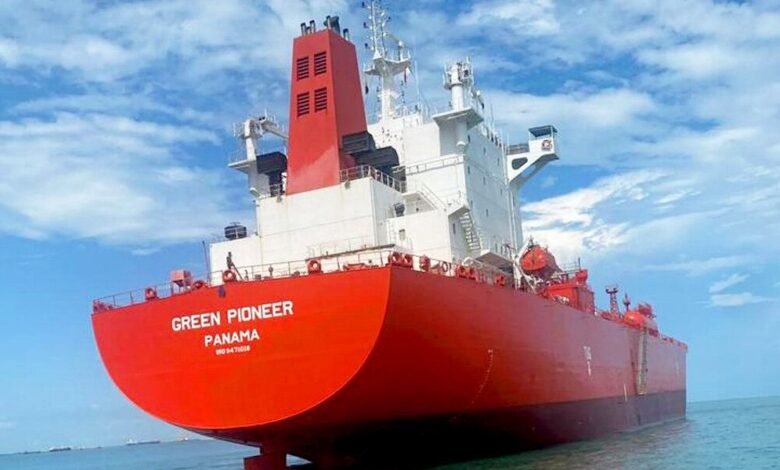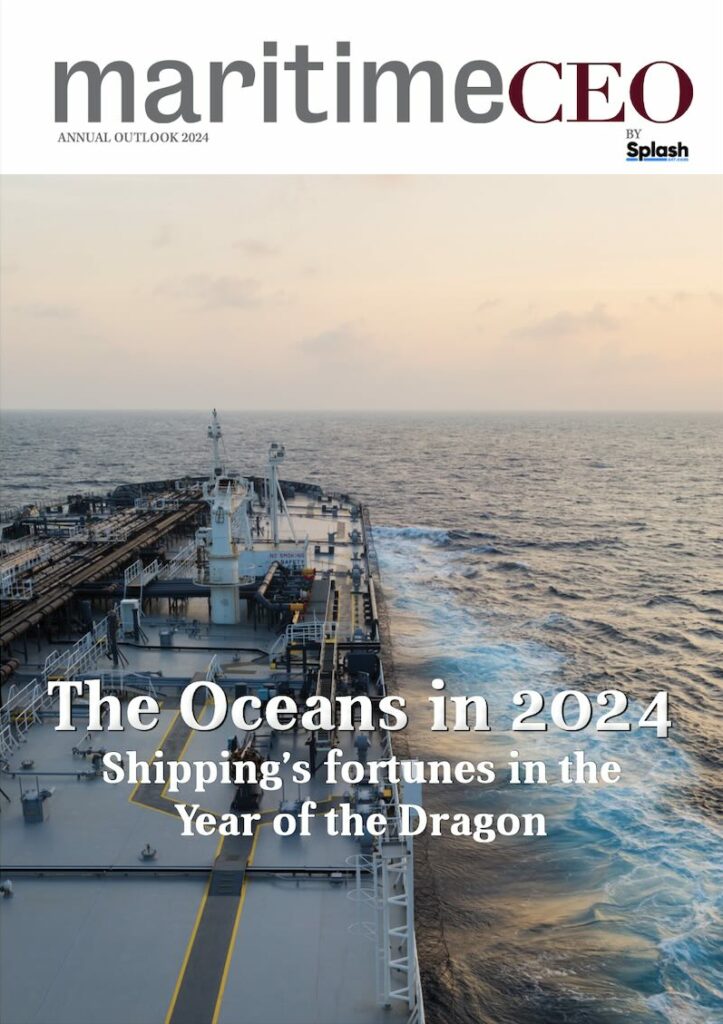The year ahead in green tech

What can shipping expect in terms of green technology breakthroughs in the months ahead? The final installment in Maritime CEO’s annual outlook.
“The year 2024 will be the first year in which it will become clear what can be achieved in the short term and what can only be achieved in the long term in environmental efforts in the shipping industry,” argues Jeremy Nixon, the CEO of Japanese containerline, Ocean Network Express (ONE).
Shipping companies are entering a period of change in 2024, he says, marked by the launch of the European Union emissions trading scheme (EU-ETS) and significant decarbonisation efforts. “Transformative change is imminent,” he predicts.
Last year’s 80th gathering of the Marine Environment Protection Committee (MEPC) has set the tone for fundamental changes in the industry which will unfold this year and beyond. Even if the detailed work has yet to be done, the commitment is there now with a net-zero target for the middle of this century, as well as interim targets for the end of this decade.
The big challenge is how to pay for it
“The implications are twofold,” says Matthieu de Tugny, president of Bureau Veritas, Marine & Offshore. “Firstly, 2024 must be a year of action; and secondly, finding ways to reduce the greenhouse gas (GHG) impact of existing ships and ship operations must be a priority.”
“Sustainability and the drive towards decarbonisation are at the forefront of shipowners’ and shipmanagers’ minds,” says René Kofod-Olsen, CEO of shipmanagement giant V.Group.
Around 80% of reductions in emissions over the next decade will come from optimisation of current assets, he reckons.
BV’s de Tugny expects that interest in and development of wind powered solutions will continue to grow this year, and key to their further expansion will be performance data as it emerges from the ever-increasing number of projects.
Kim Diederichsen, CEO of one of the leading providers of wind power, Anemoi, is happy to hear the BV prediction.
“Wind propulsion and rotorsails have found their place in modern shipping in 2023,” Diederichsen says. “With pressure growing on ship owners to go green, rotor sails are a visible, viable and cost-effective decarbonisation technology for all types of vessels as they look to improve their carbon intensity ratings.”
Performance data
The mention of performance data above is something many polled for this green tech survey highlight as a central theme this year.
“All stakeholders will need an undisputed data truth when it comes to fuel consumption , i.e. carbon emissions,” says Friederike Hesse, co-founder of zero44, a digital solution to manage environmental regulations such as EU ETS.
“Data verification will matter much more than in the past, and it can’t happen in retrospect on an annual basis only, it has to be voyage per voyage,” Hesse says.
Data verification will matter much more than in the past
“Today, transparency emerges as imperative,” argues Yanis Souami, the CEO of Sinay, a maritime data provider.
“The furniture of real-time data insights into environmental impacts will act as a guiding compass for shipping companies to optimise routes, curtail emissions, mitigate noise pollution, and safeguard critical biodiversity hotspots,” he argues.
Fuels
Undoubtedly the year ahead’s green tech news will be dominated by the future fuel debate. In 2023, half of the ordered tonnage was capable of using LNG, LPG, or methanol, according to Eirik Ovrum, principal consultant at DNV and lead author of the Maritime Forecast to 2050, who also highlights the many ongoing projects for ammonia-fuelled ships.
“Methanol will manifest itself as the short term bridge fuel of choice and we will see a significant increase in orders and production capabilities,” predicts Lasse Kristoffersen, the president and CEO of Wallenius Wilhelmsen.
This year is predicted by many polled in this survey to see more mature conversations about how shipping can source the renewable energy that will be required to produce green hydrogen, ammonia and methanol, and make them available at the global scale needed.
Of the main sectors, dry bulk stands out as the least willing to invest in green new tonnage.
According to data from AXS Marine, so far only 3% or 915 vessels are equipped with dual fuel propulsion from the total global bulk, tanker and containership fleet of 30,487 ships.
Clarksons Research data shows that strongest uptake for alternative fuels outside of LNG carriers and VLGCs where cargo can be utilised as fuel, has been in the container sector, now standing at 61% of the orderbook and car carriers at more than 90%. For the bulk carrier orderbook take-up is just 10% and for tankers it is 19%.
Nuclear
It’s only been from this decade that the prospect of nuclear propulsion being widely adopted by commercial shipping has gained any traction.
“We may hear a lot more about atomic energy in the year ahead as realisation about the scale of the challenge builds,” says BV’s de Tugny, a point of view backed up by Harry Vafias, the Greek owner running SteathGas, who tells Maritime CEO: “I also believe that we are going to see nuclear power slowly becoming the only viable solution for zero emission shipping.”
Mikal Bøe, arguably the world’s most high profile proponent of nuclear as shipping’s green bullet, in his role as CEO of CORE POWER, maintains: “There is simply no net zero without nuclear.”
CORE POWER is a UK-based marine atomic propulsion developer.
Carbon capture
This year is set to be a landmark one for pioneering projects involving carbon capture with the technology being tested on 31 in-fleet vessels, plus 22 newbuilds, according to Clarksons Research.
The industry as a whole will be watching carefully how well Singaporean yard Seatrium completes the world’s first full-scale, turnkey carbon capture and storage (CCS) retrofit of a 7MW Wärtsilä CCS system on Solvang’s 21,289 cu m ethylene carrier, Clipper Eris, scheduled to commence in the third quarter of this year. The project will use amine cleaning technology to capture 70% of the carbon dioxide in the exhaust gas from the main engine, involving the entire value chain for handling CO2, including liquefaction and storage onboard the vessel.
The technology will be piloted onboard the vessel over a year while it is operating commercially. If the pilot project is successful, Solvang intends to install the technology on some other vessels, including newbuilds, giving the rest of the industry the confidence to follow suit.
“As shipbuilders, we recognise our pivotal role in technology integration, and it is important that we ensure that our products remain relevant for future tonnage,” says Chan Eng Yew, the CEO of another Singapore shipyard, Strategic Marine.
On the topic of carbon, Jeroen van Heiningen, founder of 123Carbon, is adamant that carbon insetting will grow in popularity this year. “Carbon insetting is the most impactful instrument for transport companies seeking to share the cost and environmental benefits of their low carbon activities,” he argues.
Jens Martin Jensen, the CEO of Athenian Tankers, hopes that the coming year will see far greater investment in shore power to ships.
“I am simply amazed why IMO or other governmental bodies have not made this mandatory long time ago and it is such a low hanging fruit in the race for reduced emissions,” he says.
Another significant trend Frederik Pind, managing director of Njord, anticipates this year is the emergence of further green financing options, especially for retrofitting projects.
“This development will be a game-changer for small and mid-sized owners which make up the majority,” says Pind, whose company offers advice to owners on energy saving devices.
Note of caution
Tim Huxley, chairman of Hong Kong’s Mandarin Shipping, is not predicting any big green breakthroughs this year.
“The technology for the green transformation seems to be there, the big challenge is how to pay for it,” he says.
Quite so, agrees Marco Fioro, the CEO of Genoa-based owner Premuda.
“I am sorry to say but I believe that in 2024 there are going to be a lot of talking about the bunker of the future but I doubt there are going to be any major events,” the Italian says. “We are obliged to improve the carbon footprint of the existing fleet, but we must also be realistic in expecting changes to happen gradually.”
This, Fiori believes, is not because people do not want to do it. “Everybody is convinced that things have to change,” he concedes, “but it is difficult to make a 180 degree turnaround after more than 100 years of using oil. Things will change, the question is how fast we will be able to make it happen.”
To read the rest of the magazine for free online, click here.

